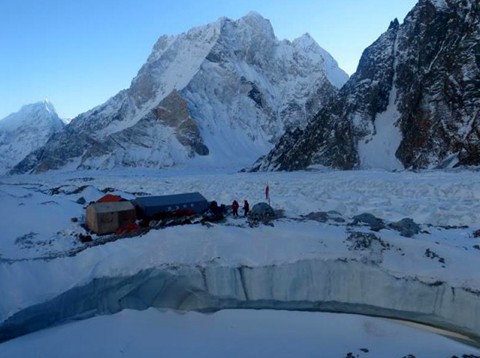
Following an arduous struggle along icy ledges and up slippery snow-packed slopes they met the challenge and triumphantly planted the flag of Poland at its summit. But the worse was yet to come.
Mountain climbers the world over agree that the descent is often far more challenging than the initial climb. Adam Bielecki, 29, and Artur Małek, 33, made it safely down to a midway camp, but Tomasz Kowalski, 27, and veteran climber 58-year-old Maciej Berbeka did not follow. Several members of the Polish expedition had stayed at a camp at 7,000 meters on the mountain in the hope of meeting up with their missing mates. Karim Hayyat, a local Pakistani climber, searched the area where the two Poles were expected to descend, but found no trace of them whatsoever.
Team leader Krzysztof Wielicki told the Polish media by telephone: “Tomasz didn’t make it to the pass. It’s been 30 hours that he’s been there and he won’t be coming down. He was already extremely exhausted. For hours, I kept urging him by telephone to move on but he was no longer able.” And then the phone contact went silent. Berbeka could be seen for a while making his descent, but then was lost from view and probably fell into an icy crevice. Not only all hope of rescuing the missing climbers soon evaporated, but more likely than not their bodies will never be found.
The rarified atmosphere and blinding snow combined with temperatures in the -30° to -40°F range plus raging winds creating a wind-chill factor as low as -70°F make winter expeditions into the Himalayas a nearly “mission impossible” challenge. Despite all the latest mountaineering gear, insulated garments, gale-proof tents and two-way communications, the “man against mountain” duel is always a toss-up even for the most seasoned climbers.
Nevertheless, winter ascents in the Himalayas have become a speciality among Polish climbers who have been the first on 10 of the 14 peaks in winter. The latest Polish ascent means that only two of the world’s 14 peaks towering higher than 8,000 meters have not been climbed in winter — Nanga Parbat (8,126 meters) and K2 (8,611 meters).
In 1975, three Polish climbers made it to the top of Gaszerbrun II, the first Polish ascent of one of the 14 tallest Himalayan peaks. Wanda Rutkiewicz became the first woman in the world to ascend K2 and the first European female to climb Mount Everest. The 1980s were a great decade for Polish mountaineering, as all the first winter ascents of the over-8,000 meter peaks were scored by Poles. The first challenge was the tallest of them all – Mount Everest, conquered by Krzysztof Wielicki and Leszek Cichy in 1980.
Poles now account for three of the world’s top seven climbers who have conquered all 14 of the world’s tallest peaks and blazed a new trail to each. The members of that exclusive club include the team leader of the latest expedition Wielicki, Piotr Pustelnik and Jerzy Kukuczka. But the Himalayas have exacted a toll. Their Polish victims have included Kukczka who died a 1989 mountaineering mishap and Wanda Rutkiewicz who went missing never to be heard from again in 1992.

And yet, despite the risks involved, this most grueling of extreme sports fascinates, intrigues and attracts, and chances are Poles will continue to be among the first to face up to the challenge. “Life is about fulfilling your dreams. No risk – no fun!” Tomek Kowalski wrote in his blog before launching the ill-fated assault.
